I am getting the following Exception
NotSupportedException: Data binding directly to a store query (DbSet, DbQuery, DbSqlQuery)
Stack Trace:
at System.Data.Entity.Infrastructure.DbQuery`1.System.ComponentModel.IListSource.GetList()
at MS.Internal.Data.ViewManager.GetViewRecord(Object collection, CollectionViewSource cvs, Type collectionViewType, Boolean createView, Func`2 GetSourceItem)
at MS.Internal.Data.DataBindEngine.GetViewRecord(Object collection, CollectionViewSource key, Type collectionViewType, Boolean createView, Func`2 GetSourceItem)
at System.Windows.Data.CollectionViewSource.GetDefaultCollectionView(Object source, Boolean createView, Func`2 GetSourceItem)
at System.Windows.Data.CollectionViewSource.GetDefaultCollectionView(Object source, DependencyObject d, Func`2 GetSourceItem)
at System.Windows.Controls.ItemCollection.SetItemsSource(IEnumerable value, Func`2 GetSourceItem)
at System.Windows.Controls.ItemsControl.OnItemsSourceChanged(DependencyObject d, DependencyPropertyChangedEventArgs e)
at System.Windows.DependencyObject.OnPropertyChanged(DependencyPropertyChangedEventArgs e)
at System.Windows.FrameworkElement.OnPropertyChanged(DependencyPropertyChangedEventArgs e)
at System.Windows.DependencyObject.NotifyPropertyChange(DependencyPropertyChangedEventArgs args)
at System.Windows.DependencyObject.UpdateEffectiveValue(EntryIndex entryIndex, DependencyProperty dp, PropertyMetadata metadata, EffectiveValueEntry oldEntry, EffectiveValueEntry& newEntry, Boolean coerceWithDeferredReference, Boolean coerceWithCurrentValue, OperationType operationType)
at System.Windows.DependencyObject.InvalidateProperty(DependencyProperty dp, Boolean preserveCurrentValue)
at System.Windows.Data.BindingExpressionBase.Invalidate(Boolean isASubPropertyChange)
at System.Windows.Data.BindingExpression.TransferValue(Object newValue, Boolean isASubPropertyChange)
at System.Windows.Data.BindingExpression.Activate(Object item)
at System.Windows.Data.BindingExpression.AttachToContext(AttachAttempt attempt)
at System.Windows.Data.BindingExpression.MS.Internal.Data.IDataBindEngineClient.AttachToContext(Boolean lastChance)
at MS.Internal.Data.DataBindEngine.Task.Run(Boolean lastChance)
at MS.Internal.Data.DataBindEngine.Run(Object arg)
at MS.Internal.Data.DataBindEngine.OnLayoutUpdated(Object sender, EventArgs e)
at System.Windows.ContextLayoutManager.fireLayoutUpdateEvent()
at System.Windows.ContextLayoutManager.UpdateLayout()
at System.Windows.UIElement.UpdateLayout()
MainWindow.xaml
<Window x:Class="TryingWPFWithUltimate.MainWindow"
xmlns="http://schemas.microsoft.com/winfx/2006/xaml/presentation"
xmlns:x="http://schemas.microsoft.com/winfx/2006/xaml"
xmlns:local="clr-namespace:TryingWPFWithUltimate;assembly="
Title="MainWindow" Height="350" Width="525">
<Window.DataContext>
<local:ViewModel/>
</Window.DataContext>
<Grid>
<ComboBox ItemsSource="{Binding Path=DatabaseContext.Schools}"> //Exception here
<ComboBox.ItemTemplate>
<DataTemplate>
<StackPanel>
<Label Content="{Binding Path=Name}"/>
</StackPanel>
</DataTemplate>
</ComboBox.ItemTemplate>
</ComboBox>
</Grid>
</Window>
ViewModel.cs
using System;
using System.Collections.Generic;
using System.ComponentModel;
using System.Linq;
using System.Text;
using System.Threading.Tasks;
namespace TryingWPFWithUltimate
{
class ViewModel:INotifyPropertyChanged
{
private DatabaseContext _databaseContext;
public DatabaseContext DatabaseContext { get { return _databaseContext; } set { _databaseContext = value; RaisePropertyChanged("DatabaseContext"); } }
public ViewModel()
{
DatabaseContext = new DatabaseContext();
}
}
}
Here is how the entity data model looks (it is very simple) -

Can anybody explain me what I am doing wrong and how I can fix this?